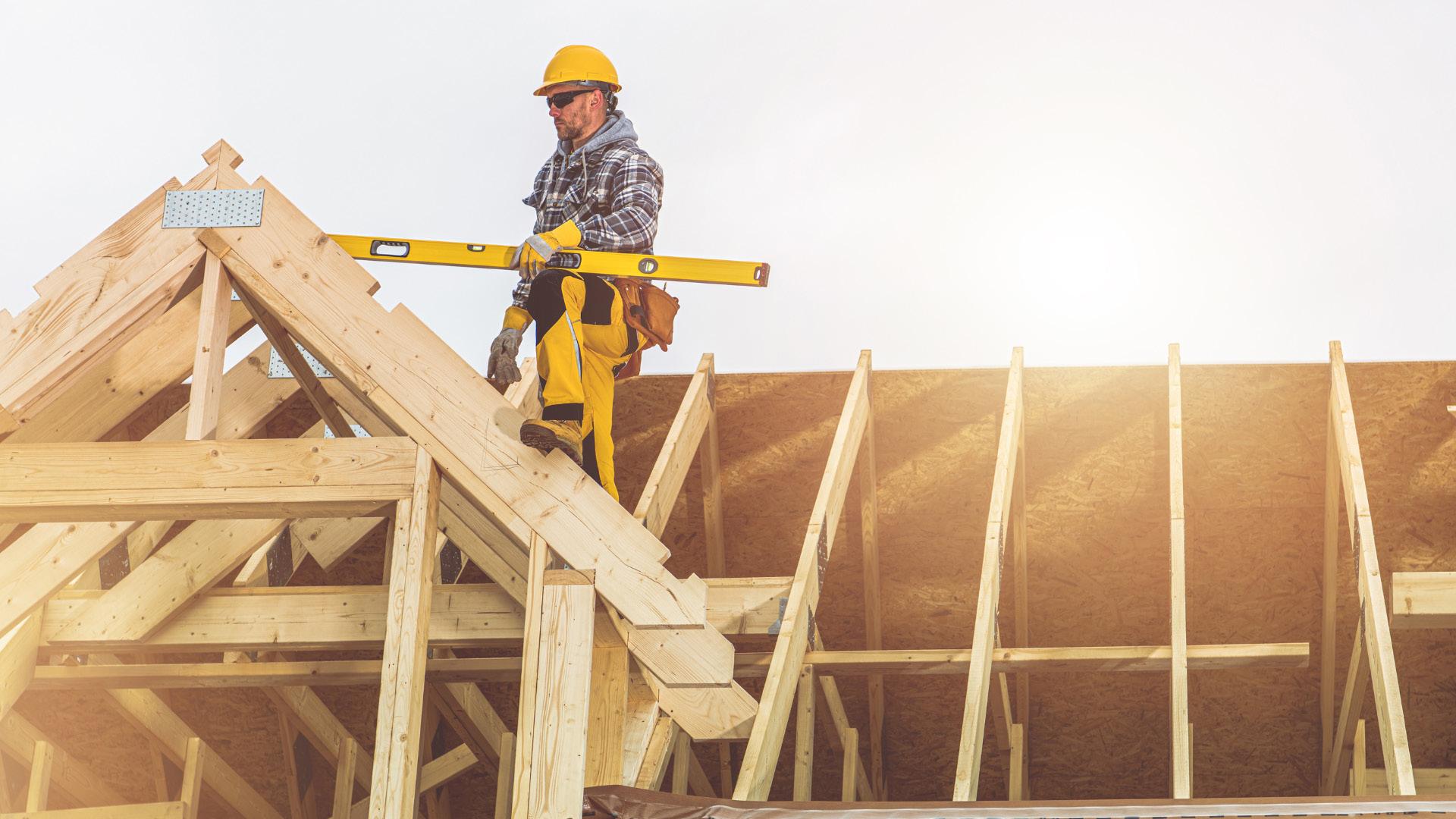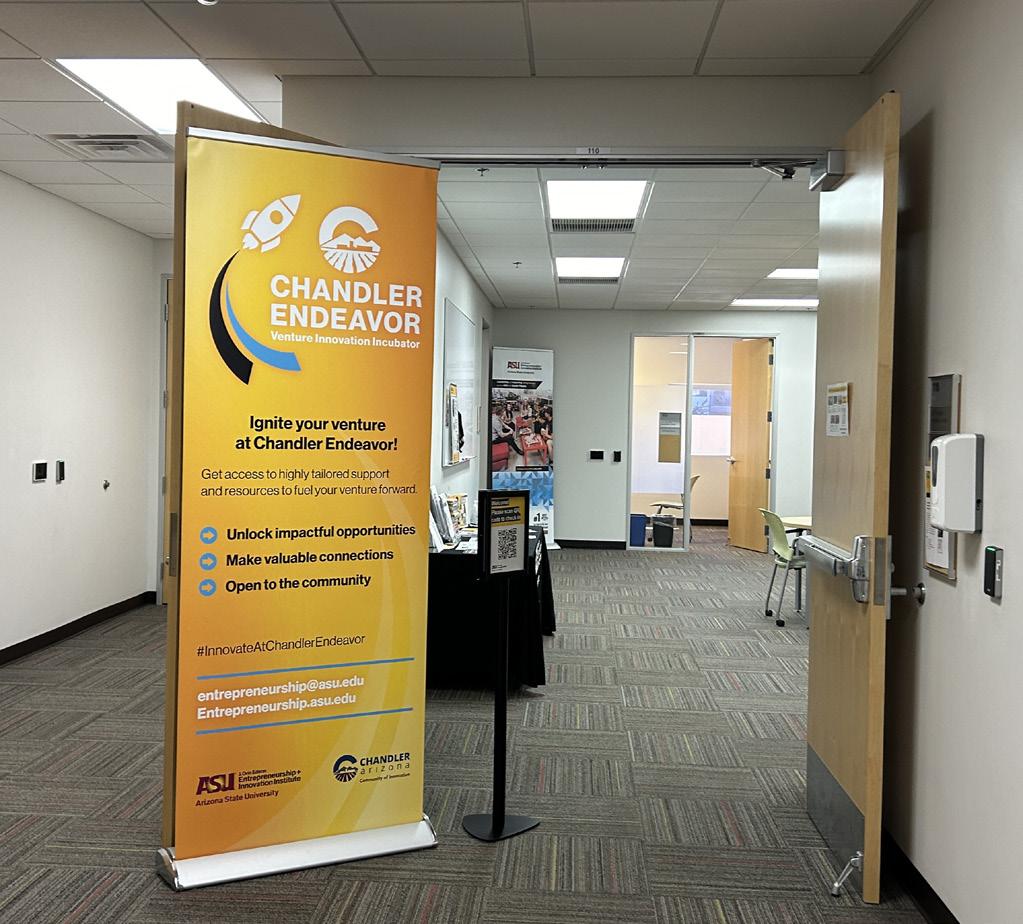
UNLOCKING ARIZONA'S ECONOMIC POTENTIAL: FORECASTING GROWTH IN 2024

OF CONTENTS I. MARCH 2024 SNAPSHOT: II. REAL ESTATE HOT BRIEFS III. FEATURED ARTICLES 5 4 6 8 10 12 Navigating the Real Estate Market Exclusive briefing on the latest trends igniting the Phoenix Real Estate Market. - If It Isn't Broken... Reinventing Real Estate Commission Structures for a New Era - Unlocking Arizona's Economic Potential: Forecasting Growth in 2024 - Arizona's Semiconductor Boom: How it's Shaping Residential Real Estate
TABLE

Bringing Arizona Together Via Real Estate, Employment, and Prosperity IV. COMMUNITY SPOTLIGHT: V. IN-DEPTH LOOK: X. ARIZONA'S RESIDENTIAL 14 16 18 Chandler, Arizona Unveiled: Discovering the Dynamic Essence of Innovation, Prosperity, and Community Spirit Chandler Endeavor Venture Innovation Incubator Arizona's Residential Construction Sector Grapples with Declining Permits Amidst Nationwide Challenges
EDITOR’S NOTE

Jaki Underwood
Welcome to the April 2024 edition of Arizona Ascent! Our mission is to illuminate and energize Arizona's real estate landscape. In this issue, we discuss timely and essential topics such as the $418 million settlement with the National Association of Realtors and the ongoing semiconductor boom in Arizona. Our magazine aims to give you a comprehensive understanding of real estate.
At Arizona Ascent, we are committed to empowering, educating, and activating our community. Whether you're a seasoned buyer or seller interested in real estate market dynamics, we aim to give you valuable insights. From practical tips to forecasting upcoming trends, we provide the knowledge to navigate the ever-evolving real estate landscape confidently.
As we delve into the latest developments, it's clear that Arizona's residential real estate market is experiencing remarkable momentum. Thank you for reading the April 2024 edition of Arizona Ascent.
Warm regards,
Jaki Underwood Editor-in-Chief ,
Page : 4
Letter from the Editor
Dear Readers,
March 2024 Snapshot: Navigating the Phoenix Real Estate Market
Overview:
The current market analysis presents a nuanced landscape characterized by a mixture of positive and negative trends across various cities. Despite most cities experiencing declines in the Cromford® Market Index, the average change remains slightly positive at 0.8%. It marks a notable decrease from the previous week's average change of 1.6%, indicating a potential slowdown in market momentum. Mesa emerges as a standout performer, single-handedly driving the average to 0.85%, underscoring its resilience amidst broader declines. However, it's crucial to note that without Mesa's contribution, the average change would have dipped into negative territory at -0.3%. Notable increases are also observed in Tempe, Avondale, Chandler, and Queen Creek, highlighting pockets of strength amid overall market fluctuations.
City Performance:
Mesa's robust performance contrasts with the downward trajectory witnessed in cities like Goodyear and Buckeye. The latter is now positioned below 70, displacing Maricopa at the bottom of the table. The disparity in performance underscores the divergent dynamics at play within the region. Market classifications reveal that while 10 out of 17 cities maintain their status as seller's markets, indicating continued demand outstripping supply, four cities are balanced, and 3 are buyer's markets. Queen Creek's recent transition back into the balanced range reflects the fluidity of market conditions. The Southeast Valley remains a stronghold for sellers, with Glendale, Avondale, and Phoenix also firmly under seller control. However, the broader market trends suggest a gradual shift towards equilibrium, particularly outside the Southeast Valley.
Supply and Demand Dynamics:
The market continues to grapple with evolving supply and demand dynamics, with demand showing a sluggish but persistent upward trajectory while supply experiences a slightly faster pace of growth. This delicate balance indicates a modest momentum towards a more neutral market, particularly pronounced in areas outside the Southeast Valley. However, it's essential to recognize that the Southeast Valley remains predominantly favorable to sellers, suggesting that the shift towards neutrality may be uneven across different regions.
Glendale, Avondale, and Phoenix retain their status as seller-controlled markets, further highlighting the resilience of seller dominance despite broader market fluctuations.
February Transaction Analysis:
A detailed analysis of February transactions in Maricopa County unveils notable trends in closed transactions and median sales prices. While the total number of closed transactions witnessed a marginal increase compared to the previous year, a significant surge is observed in the January figures, signaling a potential uptick in market activity.
Closed transactions breakdown:
Total: 5,933
Closed New Homes: 1,345 (up 11% from February 2023)
Closed Resale Transactions: 4,588 (down 2.4% from February 2023)
Median sales prices across new homes and resales demonstrate consistent growth, with the overall median sales price reaching $467,234 in February. Resale median sales prices recorded a robust increase of 7.1% compared to February 2023, while new home median sales prices witnessed a more modest growth of 0.3%.
Page : 5
Real Estate Hot Briefs
Discover Unrivaled Luxury Living at The Bergen: Phoenix's Premier Address
ASM's $300 Million Scottsdale Relocation: Sparking Growth in Arizona's Tech Hub and Real Estate Market
Experience unparalleled luxury living at The Bergen at The Grove, StreetLights Residential's latest venture in Phoenix's esteemed Camelback corridor. The Bergen sets a new benchmark for upscale apartment living with 58 meticulously designed two-bedroom residences boasting spacious layouts and premium amenities, including private outdoor living rooms with fireplaces. Residents enjoy exclusive access to a 24-hour concierge, chef's kitchen, and serene outdoor pool deck, complemented by convenient features like EV charging and a dog wash. Nestled within The Grove, residents also benefit from proximity to top-tier office spaces, dining, and entertainment options. Scheduled move-ins for Spring 2024, The Bergen promises an unmatched living experience at the intersection of luxury and convenience in Phoenix.
ASM, a prominent semiconductor supplier, is moving its North American headquarters from Phoenix to Scottsdale in a $300 million project to create 500 high-paying jobs. By relocating closer to industry giants Intel and TSMC, ASM reinforces Arizona's "Silicon Desert" status and attracts significant investment to the region's tech ecosystem. The company's commitment to sustainability is evident in its plans for LEED certification and collaboration with The Nature Conservancy, which underscores its dedication to responsible business practices. The relocation is expected to notably impact Scottsdale's real estate market by driving demand for upscale housing and presenting lucrative investment opportunities in residential and commercial properties.
ASM Scottsdale Deal: Behind the Scenes
Arizona's Tech Ecosystem and Global Recognition
ASM, a leading semiconductor supplier, is embarking on a significant relocation project, shifting its North American headquarters from Phoenix to Scottsdale in a move valued at $300 million. This strategic decision reflects ASM's intention to position itself equidistantly between Intel and TSMC, underlining its commitment to staying at the forefront of the semiconductor landscape. By consolidating functions such as research and development, training, and manufacturing engineering into a new 250,000-square-foot facility, ASM aims to create 500 high-paying jobs while enhancing operational efficiency and innovation capabilities.
The move to Scottsdale aligns with Arizona's growing reputation as the "Silicon Desert," attracting significant investment from major semiconductor players like TSMC and Intel. With reliable power, robust telecommunications infrastructure, and access to a skilled workforce, Arizona offers an ideal environment for semiconductor companies to thrive. This prominence was underscored at international events such as the Global Semiconductor Alliance Leadership Summit, where Arizona's burgeoning tech ecosystem was a focal point of discussion among global industry leaders.
Page : 6
Residential Real Estate Analysis
ASM's relocation to Scottsdale will impact the local real estate market significantly. The creation of 500 high-paying jobs will likely drive demand for housing in the area, particularly in upscale neighborhoods and communities favored by executives and professionals. With ASM's commitment to sustainability and environmental stewardship, properties in eco-friendly developments may see increased desirability among employees seeking to align their lifestyles with the company's values. Additionally, proximity to the new ASM headquarters could become a key selling point for residential properties, further bolstering property values in surrounding areas. As Scottsdale solidifies its reputation as a tech hub, real estate investors may find lucrative opportunities in both residential and commercial properties, capitalizing on the area's continued growth and development.
Luxurious Living at The Bergen at The Grove
The Bergen at The Grove, the newest addition to Streetlights Residential's portfolio in Phoenix, epitomizes luxury living in the Camelback Corridor. Comprising 58 two-bedroom residences with an average size of 2,350 square feet, The Bergen offers expansive living spaces for privacy and entertainment. Each unit boasts balconies or patios, while courtyard residences feature private outdoor rooms with fireplaces, setting a new standard for upscale apartment living.
Residents of The Bergen enjoy various exclusive amenities, including a 24-hour concierge and valet service, a chef's kitchen with private dining, and a wine and whiskey room. The outdoor pool deck provides a serene retreat with a pool, hot tub, and fireplaces, while additional conveniences such as bike repair stations, EV charging, and a dog wash cater to residents' needs. With move-ins scheduled for Spring 2024, The Bergen promises to redefine luxury living experiences in Phoenix.
Situated within The Grove, a prestigious mixed-use development, The Bergen offers residents access to Class A office spaces, upscale dining and retail venues, and premier entertainment options. StreetLights Residential's meticulous attention to detail in architecture and interior design ensures a seamless blend of style and functionality, setting The Bergen apart as a premier destination for those seeking unparalleled luxury in Arizona's thriving real estate market.
Page : 7
If It Isn't Broken... Reinventing Real Estate Commission Structures for a New Era
By Jaki Underwood
In recent years, the real estate industry has witnessed a notable departure from its conventional commission structures, signaling a pivotal shift in how agents and brokerages operate and interact with clients. Traditionally, agents would levy a commission fee tied directly to the final sale price of a property. However, propelled by market forces and evolving consumer expectations, innovative models such as flat fees and tiered commission structures have emerged as compelling alternatives, reshaping the landscape of real estate transactions.
One conspicuous trend that has gained substantial momentum is the quest for heightened transparency in commission structures. Today's consumers have unprecedented access to information, enabling them to scrutinize the fees associated with real estate transactions more discerningly. Consequently, agents are compelled to reevaluate their pricing strategies, with many opting to recalibrate their commission rates or introduce more flexible pricing models to remain competitive and responsive to client demands.

Page : 8

Moreover, the seismic disruptions induced by the COVID-19 pandemic have precipitated a profound reexamination of traditional business paradigms within the real estate sphere. As social distancing measures and remote work arrangements became the norm, the industry witnessed an unprecedented surge in virtual tours, online transactions, and remote client consultations. In response, astute agents have embarked on a journey of reinvention, leveraging technology to deliver seamless and personalized services while concurrently reimagining their fee structures to align with the evolving needs of a digitally driven clientele.
Beyond merely adapting to the difficulties of the present moment, these transformative shifts in commission structures underscore a broader ethos of innovation and adaptation permeating the real estate landscape.
Agents and brokerages are no longer content with the status quo; they explore novel avenues to enhance value proposition and elevate customer experience amidst a dynamic and fiercely competitive marketplace.
As the industry continues to chart new frontiers and embrace novel methodologies, the trajectory of real estate transactions appears poised for further evolution. Whether through the proliferation of innovative pricing models or the seamless integration of technologyenabled solutions, the future promises to be defined by a relentless pursuit of excellence and a steadfast commitment to meeting clients' ever-evolving needs. In this era of transformative change, the real estate industry stands on the cusp of a paradigm shift, wherein ingenuity and adaptability emerge as the cornerstones of success.
Page : 9
Unlocking Arizona's Economic Potential- Forecasting Growth in 2024
By Jennifer Conrad
As we enter 2024, Arizona's economic canvas reveals a mix of resilience and challenges, each influencing the state's trajectory. This detailed exploration unravels the complex interactions between demographic shifts, job market dynamics, and housing affordability trends. We offer a data-driven analysis to shed light on Arizona's economic outlook and ripple effects on the residential real estate sector.
Population Dynamics and Migration Patterns:
Job Market Resilience and Economic Metrics:
While slightly tapering in 2023, Arizona's population growth maintained its robust momentum, witnessing an addition of approximately 115,900 residents, representing a 1.6% growth rate. Notably, the Phoenix Metropolitan Statistical Area (MSA) emerged as a population magnet, welcoming 92,100 new residents, driving a growth rate of 1.8%. Behind these figures lies the significant influence of net migration, serving as the primary engine of population expansion across Arizona's metropolitan regions.
Housing Affordability Challenges and Market Dynamics:
Despite economic uncertainties, Arizona's job market exhibited commendable resilience in 2023. The state saw an average addition of 64,700 jobs annually, marking a robust growth rate of 2.1%. Leading the charge, the Phoenix MSA spearheaded job creation with 49,900 new positions, translating to a growth rate of 2.2%. Moreover, the Tucson MSA contributed 5,400 jobs, reflecting a growth rate of 1.4%. These positive indicators were complemented by a 2.5% increase in real per capita income after adjusting for inflation, signifying an overall improvement in economic well-being for Arizona residents.
Arizona confronts a pressing challenge in the form of a housing affordability crisis driven by soaring home prices and escalating mortgage rates. In the fourth quarter of 2023, a mere 21.7% of homes sold in the Phoenix MSA were deemed affordable for families with median incomes, significantly trailing the national average of 37.4%. Similar trends persisted in the Tucson MSA (32.5%) and the Prescott MSA (22.1%). This marked departure from pre-pandemic affordability levels poses a grave concern, potentially dampening housing demand and slowing market activity.
Page : 10
Implications for Residential Real Estate Market:
Strategic Insights and Future Outlook:
The confluence of these economic dynamics casts a profound shadow on Arizona's residential real estate market. While population growth traditionally spurs housing demand, the affordability crunch poses a formidable barrier, deterring potential buyers and stalling market momentum. Furthermore, the anticipated decline in housing permits signals a cautious stance among developers, exacerbating supply-demand imbalances and intensifying affordability woes. As a result, the market may witness a period of recalibration, with implications for pricing dynamics, inventory levels, and overall market equilibrium. Navigating the economic landscape of 2024 demands strategic foresight and proactive measures. Tackling the housing affordability problem necessitates a multifaceted approach, encompassing policy reforms, innovative housing solutions, and collaborative partnerships. Embracing data-driven insights and predictive analytics can empower stakeholders to anticipate market shifts and craft agile strategies to navigate evolving dynamics. By leveraging these insights, Arizona can chart a path toward sustained economic prosperity while ensuring inclusive access to affordable housing for all residents.
Arizona's economic journey in 2024 unfolds against a backdrop of resilience and challenges, each shaping the state's trajectory in unique ways. By unraveling the intricacies of demographic trends, economic indicators, and housing market dynamics, we gain invaluable insights into the opportunities and obstacles that lie ahead. Armed with this understanding, Arizona can chart a course towards a vibrant and equitable residential real estate market, where economic prosperity and housing affordability converge to create a thriving ecosystem for all its residents.
Page : 11
Arizona's Semiconductor Boom: How it's Shaping Residential Real Estate
By Jennifer Conrad
In the heart of Arizona's desert landscape, a significant technological revolution is underway, led by the semiconductor industry. This transformation impacts manufacturing and innovation and has profound implications for the state's residential real estate market, shaping upscale homes and pioneering neighborhoods.
Arizona's Semiconductor Industry Growth:
Impact on Residential Real Estate:
Since January 2020, Arizona has become a hub for the semiconductor industry, attracting a staggering $65 billion in investments from 35 companies, according to data from the Arizona Commerce Authority. This surge includes significant players like TSMC and Intel, alongside numerous smaller companies in the supply chain. The resulting job creation and economic activity have fueled demand for upscale housing options near these burgeoning tech hubs.
The convergence of cutting-edge technology and modern living has significantly transformed Arizona's residential real estate landscape. With professionals passionate about innovation flocking to these tech-centric communities, there's a surge in demand for upscale homes and forward-thinking neighborhoods. Homebuyers now seek areas close to job opportunities and offer a vibrant technological innovation ecosystem and community engagement.
Clusters of Innovation:
Supplier companies and ancillary businesses in the semiconductor ecosystem have clustered around the Valley, particularly gravitating towards TSMC's North Phoenix plant. Pinal County, especially Casa Grande, has also experienced substantial growth in semiconductorrelated companies. These clusters drive economic growth and reshape the residential real estate market as developers cater to the needs and preferences of tech-savvy professionals.
Architectural and Cultural Shifts:
Clusters of a Looking Ahead:
The influx of semiconductor giants and their associated ecosystem reshapes Arizona's physical landscape and influences its cultural and architectural identity. Modern, sleek homes are becoming the norm in upscale neighborhoods, seamlessly integrating stateof-the-art technology with contemporary design principles. Sustainability, innovation, and inclusivity are emerging as defining characteristics, reflecting the values and aspirations of residents.
Arizona's position as a global hub for semiconductor innovation is expected to continue evolving, with significant implications for residential real estate. The ongoing influx of talent and investment into tech-centric communities will drive further demand for upscale housing options and innovative urban environments. Arizona's semiconductor boom offers a market opportunity and a glimpse into the future of residential living at the intersection of technology and community.
Page : 12
Analysis of Data:
U.S. Role and Industry Transformation:
Arizona's Supportive Environment: Technological Innovation:
Industry Growth: Arizona's semiconductor industry has experienced exponential growth, attracting over $64.97 billion in investments and creating over 13,000 jobs in the past three years. This growth underscores the state's emergence as a leading semiconductor manufacturing and innovation hub.
Recent developments suggest a potential resurgence of semiconductor manufacturing within the United States, contrary to the trend of gravitating manufacturing to Asia since the 1990s. Initiatives like the CHIPS Act aimed at reshoring semiconductor production bolster domestic capabilities and reaffirm the U.S.'s position in the global semiconductor landscape.
Arizona's conducive environment for advanced manufacturing and technology, coupled with federal initiatives like the CHIPS Act, has attracted major players in the semiconductor industry. TSMC's significant investment in north Phoenix exemplifies the state's appeal as a prime location for semiconductor manufacturing.
Arizona is a manufacturing hub and a center for innovation. Companies like Ambature, Inc., headquartered in Scottsdale, have pioneered breakthroughs in microchip technology. This commitment to innovation positions Arizona at the forefront of semiconductor advancements, promising to propel the industry into new realms of possibility.

Arizona's semiconductor boom is fundamentally reshaping its residential real estate market and the shape of its communities. As the semiconductor industry thrives, the ripple effects on housing preferences, architectural design, and community dynamics will endure, positioning Arizona as a global innovation and urban living leader.
Page : 13
Arizona's Residential Construction Sector Grapples with Declining Permits Amidst Nationwide Challenges
By Jaki Underwood
As permits and housing decline nationwide, Arizona's residential construction sector faces similar challenges. Permitting activity in the state has dropped for a second consecutive year, marking a -4.5 % decrease compared to the previous year. This slowdown in Arizona's housing permits hints at housing affordability and availability challenges across the state.
Several factors contribute to this decline. Firstly, supply chain issues have piled up, hindering the timely procurement of essential materials and increasing construction costs. Secondly, loan rates for builders have been on the rise, adding financial strain and making projects less economically viable. These challenges have collectively undermined the confidence and motivation of developers to initiate new construction projects.
The future remains uncertain for Arizona's residential construction sector. While the recent drop in mortgage rates below 7% offers a glimmer of hope, signaling a potential positive shift in the housing market, challenges persist. Builder confidence is beginning to rebound, but uncertainties regarding supply chain disruptions and fluctuating loan rates continue to loom large.
Zooming into the specifics of the decline, Arizona issued 58,335 new permits last year, reflecting a -4.5% year-over-year drop. Notably, permits for single-unit buildings experienced an even sharper decline of -7.7%. In major urban centers like Tucson and Phoenix-Mesa-Chandler, the decline in new housing permits was pronounced, with drops of -8.4% and -3.6%, respectively.
Furthermore, Prescott Valley emerged as the sole small metro in the state to experience a significant decline in permits last year, with a staggering -33% decrease. Conversely, other small metros witnessed increases, with Flagstaff leading the way with a remarkable 53.4% uptick in permit issuance, followed by Sierra Vista-Douglas with a substantial 20.5% increase.
Nationally, the decrease in starts and permits exacerbates the undersupply of new homes. Last year, developers broke ground on 1,420,000 new homes, which marked a 9% drop compared to 2022. Permits are following the same downward trajectory, with the number of authorizations for new homes falling for the second year.

Page : 14

Despite the decline in new single-family homes, the total number of completed homes increased in 2023, primarily due to a 22% rise in multifamily units. Permit issuance saw a consecutive 11% decrease in 2023, following a 5% drop in 2021. Similarly, total started units fell by 9% in 2023, reflecting a negative trend in permitting activity.
Regionally, the Southern region led in permit issuance with 821,600 permits, followed by states in the West (344,500), Midwest (190,200), and Northeast (114,300). The top three states hoping to build the most shortly are Texas, Florida, and California, boasting permits higher than 100,000 and even more than 200,000. However, in 18 states, less than 10,000 permits were issued per state, with Alaska authorizing less than 1,000 new homes.
Of the 384 total U.S. metros, permits fell in 266 and increased or stagnated in 118. Amidst these challenges, there is a glimmer of hope as mortgage rates drop below 7%, potentially signaling a positive shift in the housing market. Builder confidence is beginning to rebound in response to this development, suggesting a possible resurgence in housing construction and permitting activity shortly. However, the path forward remains uncertain, and addressing the underlying challenges will be crucial for the long-term health of Arizona's housing market.
In conclusion, Arizona's residential real estate sector faces multifaceted challenges amidst declining permits and housing starts. The -4.5% decrease in permitting activity underscores housing affordability and availability concerns statewide. Supply chain disruptions and rising loan rates for builders have compounded these issues, dampening developer confidence and hindering new construction projects.
While recent drops in mortgage rates below 7% offer a glimmer of hope, uncertainties persist regarding the market's future trajectory. Builder confidence is showing signs of rebounding, but ongoing supply chain disruptions and fluctuating loan rates remain significant concerns.
Arizona's housing market exhibits regional variations, with some areas experiencing sharper declines in permits while others witness modest growth. Addressing these regional disparities and fostering sustainable growth will ensure long-term stability and affordability in Arizona's residential real estate market. Looking ahead, proactive measures to mitigate supply chain challenges, stabilize loan rates, and promote strategic development initiatives will be essential. By addressing these underlying issues, Arizona can position itself for a more resilient and balanced residential real estate landscape in the years to come.
Page : 15
Spotlight:
Chandler, Arizona Unveiled: Discovering the Dynamic Essence of Innovation, Prosperity, and Community Spirit Community
By Jennifer Conrad
Welcome to Chandler, Arizona – a city characterized by layers of innovation, prosperity, and community spirit. As we embark on a journey to delve deeper into its essence, we uncover a dynamic tapestry of opportunity and growth beneath the surface.
Chandler, AZ, stands out as one of the premier cities to live in America. Boasting a sprawling and vibrant landscape, it consistently ranks high across various metrics, affirming its status as a top destination for living. While Arizona is often celebrated as a retirement haven, Chandler defies the stereotype, captivating families and young professionals with its lively atmosphere.
Far from being a sleepy town, Chandler pulsates with energy, offering a thriving restaurant scene, vibrant nightlife, and many annual events to keep its residents engaged year-round. From the lively Ostrich Festival to the sophisticated Downtown Chandler Fine Art and Wine Festival, from the flavorful Southwest Cajun Fest to the soulful Chandler Jazz Festival, there's no shortage of entertainment options.
This energy is not limited to the city's entertainment scene; Chandler's economic landscape has also significantly transformed from its agricultural origins to a thriving high-tech industry center. Over 30 companies from the Fortune 1000 list have made Chandler their home, contributing to its diversification and economic stability. Chandler is a vital gateway to regional and global markets in the Phoenix metropolitan area, bolstering its economic vibrancy. These companies collectively employ over 35,000 individuals, representing around 30% of the city's workforce.
At the heart of Chandler's economic success lies its ecosystem of innovation. The city boasts an
extensive, ultra-pure nitrogen pipeline, a high-speed telecommunications network, and redundant water systems, offering businesses the infrastructure needed for growth. Chandler's partnership with educational institutions like Arizona State University's Polytechnic campus ensures a steady stream of talent and ideas, driving forwardthinking research and development initiatives.

Page : 16

Chandler's commitment to sustainability is reflected in its infrastructure investments. The city's low water and wastewater rates and high-capacity utilities provided by SRP, APS, and Southwest Gas underscore its dedication to environmental stewardship. Chandler's municipal airport also facilitates business travel and logistics, further supporting economic growth while minimizing environmental impact.
Beyond its economic achievements, Chandler is experiencing a cultural renaissance driven by its diverse population. The city's recognition as the 6th Best City for Families and the 15th Best City for Women Entrepreneurs speaks to its commitment to inclusivity and community engagement. Chandler's vibrant events calendar celebrates its rich heritage while embracing new traditions, fostering a sense of belonging among residents.
Chandler remains dedicated to enhancing residents' quality of life, with a median household income of $126,000 in 2022 and an average household income of $133,000. Additionally, Chandler's median home value of $399,473 reflects its affordability relative to its economic prosperity, making it an attractive destination for newcomers and long-time residents.
Chandler's journey toward prosperity is mirrored in its growing population, which has surged from 9,531 in 1960 to 287,385 as of March 1, 2024. The city's diverse community showcases its rich tapestry of cultures, with White, Hispanic or Latino, Asian, and Black or African American populations contributing to its vibrant social fabric.
As Chandler continues evolving, its innovation and resilience spirit remain unwavering. With a projected population of 309,100 by 2030, the city is poised for continued growth and prosperity. By embracing diversity, fostering innovation, and prioritizing sustainability, Chandler stands ready to shape the future for its residents and communities worldwide. So, come along as we peel back the layers of Chandler, Arizona, and uncover a city defined not by its size or stature but by its unwavering commitment to progress and prosperity.
Page : 17
Chandler Endeavor: Arizona's All-Inclusive Incubator
Fostering Entrepreneurial Innovation
By Jennifer Conrad
Chandler Endeavor is an exciting and innovative incubator that provides support and resources to entrepreneurs and businesses in Chandler, Arizona. This dynamic creativity center offers a wide range of programs and initiatives tailored to meet the unique needs of diverse business ventures. Chandler Endeavor is a true testament to Arizona State University's commitment to community engagement and inclusive collaboration, as this entrepreneurship resource is open to everyone, regardless of their background or level of expertise.
In August 2023, Chandler Endeavor created history by hosting a grand ceremonial ribbon-cutting to celebrate its official launch. The initiative was made possible by a visionary partnership between
the City of Chandler and Arizona State University, which received a generous grant of $275,000 to support the project. Kristin Slice, Director of Community Entrepreneurship at Arizona State, led the Chandler Endeavor initiative. Their goal is to help over a thousand entrepreneurs and startups by providing an all-inclusive ecosystem that fosters innovative ideas and allows aspiring entrepreneurs to explore their potential fully. Standard incubators usually serve only 10 to 15 people yearly, but Chandler Endeavor's incubator program is different. It is designed to serve many people and provides extensive support to help entrepreneurs and startups succeed.
Chandler Endeavor welcomes aspiring entrepreneurs from all backgrounds, unlike other incubators that require entrepreneurs to apply and be selected for a cohort. There are no barriers to entry, and everyone is encouraged to participate. When you first enter Chandler Endeavor, Senior Program Manager Arian Shirakhoon will be there to greet you and provide guidance. They will offer you a complimentary coworking space where collaboration knows no bounds and direct you to a wayfinding meeting where you can learn more about the incubator's programs and initiatives. Participants can also access the building's fabrication studio to create a prototype.
Startup founders who register with Chandler Endeavor will be grouped into cohorts with a six-month timeline to help them stay on track. The incubator tailors its support to meet the unique needs of each venture by customizing the experience based on diverse industries and business models. Despite the varying nature of the ventures, the overarching goal is to assist businesses in scaling and growing. This is achieved through personalized meetings with staff members to assess the stage of the venture and direct them to appropriate resources, whether at the beginning stages or more advanced.


Page : 18
In addition to personalized support, the incubator offers a mentor program where registered members can access one-onone mentorship with seasoned entrepreneurs and investors like Glenn Thomas. These mentors provide tailored guidance and support to help participants navigate complex challenges and achieve their goals.

"We've established a comprehensive training framework called Training Development Resources to foster entrepreneurship," said Shirakhoon. These modules, developed in collaboration with ASU, cover various aspects crucial to entrepreneurial success, such as customer discovery, go-to-market strategy, and the art of investment. Complementing these modules are monthly signature forums, each dedicated to exploring different themes or topics in entrepreneurship. These forums serve as invaluable platforms for knowledge exchange and networking, typically drawing a diverse audience of 20 to 35 individuals.
After six months, participants graduate to our advanced curriculum in the spring cohort. In the fall, Chandler Endeavors offers six modules to guide them through essential concepts. "Following each cohort, there is a pitch competition, like our recent East Innovation Night, where participants showcase their progress before advancing to the spring cohort, which delves deeper into advanced topics," said Shirakhoon. This non-traditional approach emphasizes selfdirection rather than a boot camp or accelerator model. Participants are encouraged to stay engaged and motivated, as their onus is to seek assistance and resources.

But Chandler Endeavor is not just about education; it's about building a community. The monthly signature forums are the heartbeat of this vibrant ecosystem – a space where individuals converge to explore pressing entrepreneurial topics. Through interactive workshops and insightful discussions led by seasoned investors and entrepreneurs, attendees gain invaluable insights and forge meaningful connections. Chandler Endeavor is where entrepreneurs can thrive, grow, and succeed, thanks to the support of an engaged community and innovative programs and initiatives.
Page : 19


Title insurance assures owners that they are acquiring clear title. It is designed to eliminate risk or loss caused by defects in title from the past. Title insurance provides coverage only for title problems which were already in existence at the time the policy was issued. Why

Named to the Fortune 500 on an annual basis The only Fortune 500 company in its industry Identified by Forbes as a Global 2000 Company Chosen by Forbes as one of The World’s Best Companies Selected by Forbes as one of the Best Managed Companies in America Named by Forbes to the Platinum 400: America’s Best Big Companies 150 years of Title & Escrow Experience
Fidelity
Agency
Fidelity
is
is
WICKER Jill WICKER FNTArizona.com SALES EXECUTIVE 317-313-7179 Jill.Wicker@fnf.com
National Title
Why
National Title Agency What
Title Insurance What
Title Insurance Committed to Providing You Committed to Providing You Exceptional Service Exceptional Service Jill






















